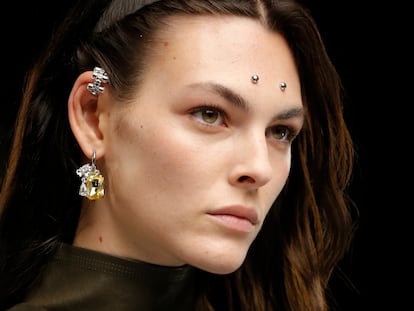Colorimetry: The art of finding the colors that suit you best
Not everything works the same for everyone; factors such as tones, undertones and ‘seasons’ are relevant when looking for your perfect wardrobe

When choosing new clothes, we usually follow a two-pronged approach: on one hand, we want a flattering piece; on the other, we want something fashionable. But this formula relegates color to the background, even though it can bring out a person’s features and peculiarities.
But Colorimetry, which seeks to highlight an individual’s most attractive qualities through color, is becoming increasingly sought-after, as seen by the many videos that nowadays flood social networks.
María Uranga, image consultant and director, has no doubt about it: colorimetry must be taken into account to provide the best service to a client. When a person goes to one of these studios, they learn about which colors flatter them, and which do not, explains the expert. She points out that, when purchasing a garment that will be close to the face, like a scarf or a T-shirt, it is better to buy one that is within your color range. “This way, the face looks more rested and the color of the chosen garment will act as a natural flash ampoule,” she says.
A universe of colors and temperatures
Color transmits emotions and ideas because, culturally, we associate a series of attributes to tonalities, based on historical, social and artistic contexts. This can be seen in movies, in photography, in painting and, of course, in fashion.
The first step in any study of color is identifying the person’s tone and undertone. Teresa Torres, specialist in fashion communication, image consultant and stylist, states that tone determines which color family the feature we are looking at belongs to (like blues, greens or pinks), while the undertone refers to the color temperature (cool or warm). “There can be two people whose skin tone is pink, but one has a cool undertone, like Anne Hathaway, and the other has a warm undertone, like Amanda Seyfried,” explains the expert.
If you are curious about which of the two groups you belong to, the best-known trick is to look at the root of your hair: warm people have golden reflections from the hairline, while cool people tend to have a more uniform or ashy tone. You can also look at your lips. If they have a more orange hue you may belong to the warm group, and if they are lilac you are probably in the cool one.
This applies to most features: the undertone of the eyes is also a classic indicator, as is the color of the veins, which tend more towards the bluish in cool people and the greenish in warm ones. If you need a little help, you can also use objects: holding silver and gold or pink and orange fabrics close to your face, you can see how pink and silver automatically light up the skin of cool people, and vice versa. These tests are usually the clearest when it comes to discovering the group a person belongs to.
Once this has been established, it is time to move on to a second matter that for many is the hardest to identify: the color season.
A kingdom of nuances
Your color season will determine your corresponding color palette. Spring and fall include warm people, while summer and winter are for the cool ones. Making a (very wide) generalization, saturated and bright colors suit spring people better, while warm colors work best for autumn people. The summer group looks better with bright, pastel colors, and winter people shine with pure, intense colors.
Mikaela Carrizo, an Argentine stylist based in California, argues that, in fact, there are not only four seasons, but 12, as there are nuances within each of the main ones. The best thing you can do to find the group you belong to is to visit one of these professional studies. There is a large number of blogs and videos that publish content on this topic, which can lead to confusion and misinformation. However, there are some basic notions that can help you carry out a first approximation.
Winter people are defined as a cold group that sports great contrasts between the color of their hair, eyes and skin. The depth of their features stands out, and their skin can go from very light to very dark. Summer people usually have ashen hair, light eyes and rosy skin, also with a cool undertone. Those who belong to the autumn season, are characterized by deep brown features with golden and copper highlights, as well as peach and tan skin with a warm undertone. Finally, the spring group includes fair and bright skin with golden and copper hair, also with a warm undertone.
So what happens if you dye your hair or tan? Mikaela explains that the station remains the same despite these changes, as the undertone is not altered by them; thus, you will always look better in the tonalities of your original season.
Above all, relax and be yourself
The point of all this knowledge is to improve self-esteem; to help you save time and money when you shop and to be of assistance in finding more flattering and easier color combinations. Nevertheless, you should use these tools to increase your self-awareness and turn them to your advantage – never to obsess or render half your closet useless. There are many other things to like about colors, and one should never refrain from wearing them out of a need to shine at all moments.
Furthermore, color is also a very personal matter. If we force ourselves to choose exclusively the shades that flatter us, regardless of how comfortable we feel with them, we may end up feeling dissociated from our own image. The goal to acquire all this information and bring it to your turf, so you can take advantage of the techniques that you have at your disposal, such as colorimetry and color studies.
“I’ve seen people who have made a 180-degree turn in their personal image thanks to a simple study of color. But be careful: when it comes to personal image, it’s very important to make sure that, along with the change, your mind connects with your heart at all times. If this doesn’t happen, what you wear will be just a disguise,” reflects María.
Tu suscripción se está usando en otro dispositivo
¿Quieres añadir otro usuario a tu suscripción?
Si continúas leyendo en este dispositivo, no se podrá leer en el otro.
FlechaTu suscripción se está usando en otro dispositivo y solo puedes acceder a EL PAÍS desde un dispositivo a la vez.
Si quieres compartir tu cuenta, cambia tu suscripción a la modalidad Premium, así podrás añadir otro usuario. Cada uno accederá con su propia cuenta de email, lo que os permitirá personalizar vuestra experiencia en EL PAÍS.
¿Tienes una suscripción de empresa? Accede aquí para contratar más cuentas.
En el caso de no saber quién está usando tu cuenta, te recomendamos cambiar tu contraseña aquí.
Si decides continuar compartiendo tu cuenta, este mensaje se mostrará en tu dispositivo y en el de la otra persona que está usando tu cuenta de forma indefinida, afectando a tu experiencia de lectura. Puedes consultar aquí los términos y condiciones de la suscripción digital.
More information
Archived In
Últimas noticias
Most viewed
- Sinaloa Cartel war is taking its toll on Los Chapitos
- Oona Chaplin: ‘I told James Cameron that I was living in a treehouse and starting a permaculture project with a friend’
- Reinhard Genzel, Nobel laureate in physics: ‘One-minute videos will never give you the truth’
- Why the price of coffee has skyrocketed: from Brazilian plantations to specialty coffee houses
- Silver prices are going crazy: This is what’s fueling the rally










































